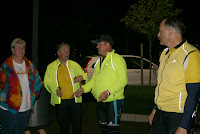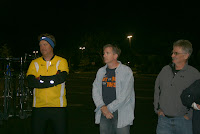 Ride, Drive, Sleep?, Repeat. Emphasis on the question mark after "Sleep"! Team Learning4Life and our amazing crew met at 7 a.m. at the parking lot of Arrowhead Christian Academy this past Saturday, packed up two motor homes and two support vehicles and then left for an epic 24 hour training ride that took us from downtown Oceanside, CA all the way across the border of Arizona in preparation for the Race Across America. It was an exercise in challenging cycling over sometimes difficult terrain, night riding, fast, steep descents, sometimes brutal weather conditions (35-40+ mph wind gusts at night) and sleep deprivation on behalf of us all - THAT'S HOW WE ROLL!!!!!
Ride, Drive, Sleep?, Repeat. Emphasis on the question mark after "Sleep"! Team Learning4Life and our amazing crew met at 7 a.m. at the parking lot of Arrowhead Christian Academy this past Saturday, packed up two motor homes and two support vehicles and then left for an epic 24 hour training ride that took us from downtown Oceanside, CA all the way across the border of Arizona in preparation for the Race Across America. It was an exercise in challenging cycling over sometimes difficult terrain, night riding, fast, steep descents, sometimes brutal weather conditions (35-40+ mph wind gusts at night) and sleep deprivation on behalf of us all - THAT'S HOW WE ROLL!!!!!Our trip was almost cut short due to the gusty winds we experienced starting at the top of the mountain in Ranchita all the way down the 3500 foot descent to the valley floor below that is called the "glass elevator" and then on from Borrego Springs past the Salton Sea to the small town of Palo Verde where we made another rider transition. Gusts were sometimes over 40 mph at night during the second rider rotation. The guys experienced the benefit of an awesome tail wind that allowed them to ride at an average of 25 mph for many miles, but when the direction of the road changed, they had to deal with a brutal crosswind that drove sand and debris into them as they tried to cover the last 30 miles of their rotation. It also made for unsafe driving of the motor homes. Team Captain Doug Richards and Assistant Crew Chief Randy Sperling and the riders jointly made the decision to keep moving forward...slowly...to see if the winds would let up, which they eventually did.
 Here is how the race process works...or at least is SUPPOSED to work. 5 riders start a 6 hour rotation. The first rider takes a leg, typically 5 to 10 miles depending on terrain, weather conditions and the rider's present physical/mental condition (which can vary greatly over 7 straight days of RAAM riding). The rider begins his leg with a support vehicle trailing behind him for safety (and lighting at night). The other 4 riders go ahead along the route in the "rider" vehicle, driven by one of the team members with another navigating using the RAAM route book. They travel to the predetermined transition point and prepare the next rider and his bike for the next route. When the first rider approaches, he must ride his bike so that his front wheel passes the next rider's rear wheel at which point rider number two takes off. This can be done at a stationary position or both riders can be moving - the method varies based on the safety and conditions of the transition location. Once the transition is made and the next rider is off, the first rider puts his bike on the rack on the "rider" vehicle, hops in and the process starts over again.
Here is how the race process works...or at least is SUPPOSED to work. 5 riders start a 6 hour rotation. The first rider takes a leg, typically 5 to 10 miles depending on terrain, weather conditions and the rider's present physical/mental condition (which can vary greatly over 7 straight days of RAAM riding). The rider begins his leg with a support vehicle trailing behind him for safety (and lighting at night). The other 4 riders go ahead along the route in the "rider" vehicle, driven by one of the team members with another navigating using the RAAM route book. They travel to the predetermined transition point and prepare the next rider and his bike for the next route. When the first rider approaches, he must ride his bike so that his front wheel passes the next rider's rear wheel at which point rider number two takes off. This can be done at a stationary position or both riders can be moving - the method varies based on the safety and conditions of the transition location. Once the transition is made and the next rider is off, the first rider puts his bike on the rack on the "rider" vehicle, hops in and the process starts over again.While this is going on, the other 3 riders are in a "rest" cycle, hopefully sleeping in the "sleep" motorhome which is traveling ahead approximately 100 miles to the next major transition point. When the riders make it to the major transition point, 3 of them go out of the riding rotation and into thier own "sleep" cycle while the hopefully fresh riders come off their sleep cycle and join the "rider" rotation. This is how we will travel 3000 mile across the country.
 While the process sounds good and like it should work smoothly in theory, the REALITIES of this process?
While the process sounds good and like it should work smoothly in theory, the REALITIES of this process? - Riders get very little sleep during a sleep cycle as it is extremely difficult to sleep soundly in a moving motorhome that is constantly stopping and starting and turning
- Riding at night on lonely, dark, isolated roads is challenging and sometimes dangerous. Even with adequate lighting, it can be difficult to see potholes and debris on the road that can cause an accident
- In the rider rotation, there is no time for restroom stops, so when nature calls...well, you figure it out.
- Our 14 person crew (motor home drivers, support vehicle drivers, cook, crew chief, assistant crew chief, communications director) must go through work and rest cycles also - and they don't sleep well either.
- Showering is difficult in a moving motor home
- Riding around in an SUV with four other sweaty, stinky, tired, hungry men is sometimes unpleasant. OK, its MOSTLY unpleasant! :)
- Weather is often a factor. Riders must ride in any temperature or weather situation. Temperatures from 10 to 110, high humidity, rain, winds - whatever. About the only thing we will stop for is a tornado or a flood. And we'll think hard about stopping for either of those.
- The difficulties involved in these processes grow exponentially greater over the 7 day period it will take to complete the race

























